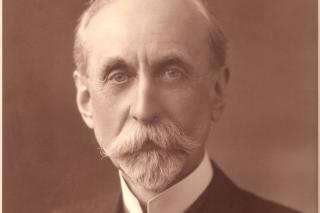Simmons School of Library and Information Science students in Assistant Professor of Practice Mollie Metevier’s “Digitization Project Planning and Management” (LIS 462) course recently presented a project showcase of the digitization of the Jeffrey R. Brackett Papers, the first dean of Simmons School of Social Work (SSW). This project was done in collaboration with the Simmons University Archives.
“From the outset, this project has been completely student-driven,” said Assistant Professor of Practice and Manager of Field Experience Mollie Metevier, prior to the event, noting that the students chose this particular collection of papers to coincide with SSW’s 120th Anniversary.
A Historical Overview of the School of Social Work
Originally called the Boston School of Social Work, Simmons’ SSW is regarded as the first school of social work in the nation. The School was established in 1904 in an arrangement between Simmons (then College) and Harvard, until 1916 when Harvard left the arrangement and the School was connected only to Simmons.
During the presentation, students Ella Whiteside ’26MS, Brandon Lebel ’26, Naomi Adamsky ’24 ’25MS, and Allison Bodznick ’25MS shared the process of digitizing the papers, including the various practices, issues, tools, and techniques they used. They shared a brief biography of Jeffrey Brackett, an alumnus of Harvard and Johns Hopkins who served as the School’s inaugural dean from 1904 to 1919. A prominent figure in the field of social work across the eastern and midwestern US, Brackett left materials from his personal and professional life. These included notes, correspondence, newspaper clippings, speeches, and published and unpublished writings.
“[There were] exciting issues in this collection to tackle,” student Brandon Lebel noted, “such as different paper types and oversize materials.” The students had to decide what to do in each of these situations, and how the materials would be accessed once digitized.
Research and Project Planning
First, for the research phase of the project, the class split into five groups, each responsible for writing a white paper on their assigned subject. These included rights and legal issues, quality assurance, metadata and standards, usability and interface, and digital preservation.
From the results of this research, the class made decisions about how to digitize the papers, including ascertaining whether they were violating copyright laws, best practices for file organization, and the best standards of metadata (specifically, data used to describe the data in the digital resources). The group chose Dublin Core, a commonly used metadata standard. They also discussed who the intended audience was, how they could adapt the collection to suit the needs of that audience, and how best to make the digital materials accessible.
As students worked within the limited time of a 12-week course, they first determined what work could be done on- and offsite. They also learned the unique quirks of the tools they were using: if left alone for too long, the scanner would log the user out automatically. It could also log out if too much was scanned at one time.
“We had one scanner per group, and two people per group using the scanner during class time,” said Lebel. “If one student was scanning, what would the other person be doing?”
The students created a workflow to address these issues. In this instance, the second person would review each scan before moving on to the next to avoid the need for duplicative work.
In addition, they had to create an equitable distribution of work. “Not all the boxes had the same amount of material,” Lebel shared. “[Some boxes had] six folders, others had 20.” Among these were single pages, entire journals, or newspapers. “We had to strategize and make a plan for how to tackle this.”
The full collection, “Jeffrey Richardson Brackett papers (MS 008), 1728–1956,” is now accessible on the Simmons University Digital Archives (SUDA). The items have been separated into two categories: personal materials and professional records.
The students also created an Omeka exhibition, which presents select items of correspondence between Brackett and his colleagues. These include a 1903 Letter from Alice Higgins to Jeffrey Brackett about setting up a social work program for Simmons and Harvard. Higgins was a social worker from 1870 to 1920. From 1903 to 1913 she was general secretary of the Associated Charities of Boston. The letter addresses social services as an academic discipline while serving as an example of correspondence with a woman of the profession.
While the collection was mostly flat paper, there were some items that could not be scanned. There is a scrapbook that was deemed too fragile, the paper too thick to be scanned with a flatbed scanner. There was also a silver baby spoon; this item, the students learned from the Simmons archivists, was a popular item to have in that era. The scrapbook and spoon are also kept in the Simmons Archive.
Digitization Offers Insight into Social Work Pioneer
Professor Metevier shared her views about the importance of the collection.
“The Jeffrey R. Brackett papers are a reflection of the personal and professional life of one of the key players in Simmons' pioneering role as the first institute of higher learning to have an affiliation with a school of social work,” said Metevier. “Through the class' digitization efforts, we have a unique opportunity to learn about aspects of Brackett that may not otherwise be known, from his hobby as an amateur chicken farmer to the way in which he gathered information and annotated documents to write his many speeches. His collection is a patchwork kaleidoscope of ‘scrip-scraps’ — a term coined by the class — that gives a first-hand glimpse into Brackett's life.”
The students thanked Archivist and Digital Initiatives Librarian Kelsey Kolbet, Archives and Digital Initiatives Fellows Hannah Gershone and Zoe Johnson, and Professor Metevier for their support on this project.
Students in Metevier’s Spring 2025 Digital Libraries course include: Aaron St. Michel, Allison Bodznick, Ashley Holladay, Brandon Lebel, Elizabeth Pickett, Ella Whiteside, Kendall Dawson, Marion Hamilton, Myshko Chumak, Naomi Adamsky, and Tracy O'Donnell.

